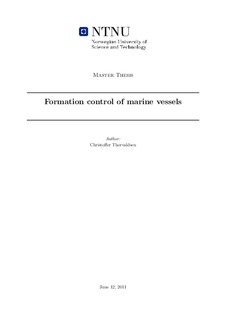| dc.description.abstract | As an enabling technology of coordinated multi-vessel operations, formation control has received considerable attention in recent times, with specific applications ranging from satellites in space to wheeled robots on the ground. This thesis will serve as a continuation of previous efforts within the marine control community, focusing on formation control design for fully actuated marine surface vessels. The main objective for the designs is to enable a group of vessels to automatically position themselves in a specified formation structure, which in turn should propagate along a parameterized path at a desired speed. Although this problem statement forms the basis of many designs in the literature, a new approach is taken herein where the vessels establish the formation in their immediate vicinity prior to initiation of a collective movement towards the path. This separation between group coordination and path following has, at least to the authors knowledge, not been pursued in previous works.
In Chapter 1, terms relevant to formation control systems are explained, and a review of earlier work is conducted. Mathematical background is given in Chapter 2, after which the control designs take center stage in Chapter 3. Three different designs are presented. The first two combine a decentralized group coordination framework with maneuvering theory, utilizing the former to coordinate the vessels into a formation, and the latter to ensure subsequent path following. Generic maneuvering theory forms the basis of the third design, where an intuitive Line-of-sight steering algorithm is incorporated to ensure feasible and predictable motion towards the path for the formation. Strong, global stability results are achieved for all three designs, and computer simulations in Matlab/Simulink are used to illustrate their performance.
In Chapter 4, the proposed control designs are evaluated with respect to inter-vessel communication requirements, behavior during vessel failure scenarios, collision avoidance capabilities, and transient behavior during group coordination and path following. An ability to maintain formation structure during mild and severe single vessel failures is demonstrated, illustrating the intuitive notion that the separation and prioritization of group coordination and path following increases safety. However, a guarantee against collisions is not given, as none of the designs incorporate explicit collision avoidance capabilities. Moreover, the designs are shown to require considerable inter-vessel communication during operations in general, which could limit their applicability for large groups.
| nb_NO |
